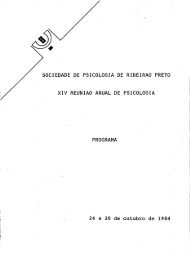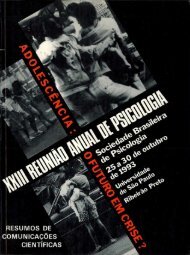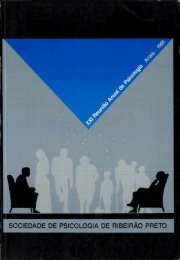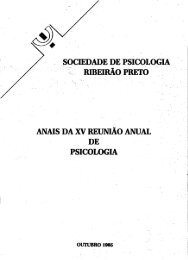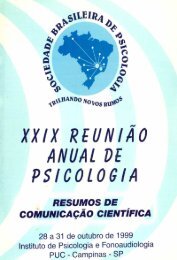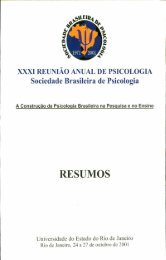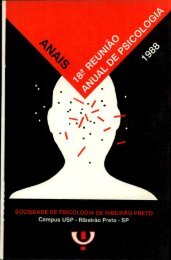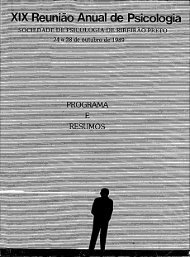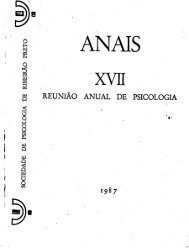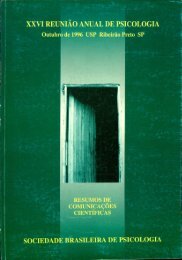- Page 2 and 3:
SOCIEDADEDE PSICOFOGIA DE RD EIR:O
- Page 4 and 5:
DIRETOG DA SOCV DADX DE PSIPOLOGIA
- Page 6 and 7:
REPRESENTAkl'ks LocM j Ana Marfa I/
- Page 8 and 9:
AG RADECD TENTO S A DiretoriadaSoci
- Page 10 and 11:
- A cultum como metada ciênciado c
- Page 12 and 13:
9.Avaliaçâo psicolögica com vist
- Page 14 and 15:
XIII - Ux e li- m ix ce iale s33v e
- Page 16 and 17:
l8.Dœ nçasafetivas:aimporta-nciad
- Page 18 and 19:
' l SESSâO U AUGIIRM ,DA xx loruxl
- Page 20 and 21:
infornuçâod'e m losproblemns'psic
- Page 22 and 23:
* . J ' a pnmeita Rleçâo demotori
- Page 24 and 25:
a Retmiâo le eriase organizarnasdi
- Page 26 and 27:
' . * CURSO S 1.Medlclna CommHnment
- Page 28 and 29:
' ' 11 ! melhonmdo sua conmiências
- Page 30 and 31:
Exemplosde programasquearim atlmm H
- Page 32 and 33:
15 CONCEITUK iO EDESCRWV DO ATENDW
- Page 34 and 35:
17 O Ambulatôrlo D - iall- do deCl
- Page 36 and 37:
Objetivosdo Psicôlogo:1)Atendero p
- Page 38 and 39:
A pahirdex- dados,foifeitaumn compa
- Page 40 and 41:
Treino de Acqertividade,m elhorando
- Page 42 and 43:
preasul> toscomplementarese denptur
- Page 44 and 45:
' 27 quase epidêmico.Elaacompnnhaa
- Page 46 and 47:
29 . . . ' . . o INDIVDUAL: o co/Ei
- Page 48 and 49:
aatribuirà razâo 11m m derdetermi
- Page 50 and 51:
como umaaçâo em queam rcem âo en
- Page 52 and 53:
' 35 ,. . . . . . . .. . # : '' ' .
- Page 54 and 55:
ou,como nosamen rfamosa aflrnur,tom
- Page 56 and 57:
Estam os solicitando sua colaboraç
- Page 58 and 59:
41 PSICODG G CADO MOVM YTO EU RESSW
- Page 60 and 61:
EukenéticaeoT- nvolvimentotiaPev n
- Page 62 and 63:
45 GESTALT.TERMM :UMAALTERYAIW APAM
- Page 64 and 65:
Isto'pode ser conseguido autodidati
- Page 66 and 67:
49 A PSICOLOGIA ECOLJGICA: o Qtc t
- Page 68 and 69:
I 4.A explomçâo desordenndadofont
- Page 70 and 71:
53 Acm AbE:ö AMBIENTE coxsTRum o '
- Page 72 and 73:
p.' W O QK SH OPS W ORKRHOPI ') AVA
- Page 74 and 75:
altemç&s nele,Sklnnerprecisa recor
- Page 76 and 77:
detenninadacurvadeextinçâo,reflet
- Page 78 and 79:
61 ' diferentesreservas;h)é utiliz
- Page 80 and 81:
explicarasalteraçöesobservadasnah
- Page 82 and 83:
65 dl-ferentementeacçsgfvelsob dif
- Page 84 and 85:
Ou ainda quando,m esm o reconhecend
- Page 86 and 87:
portanto,a form a da curva é depen
- Page 88 and 89:
sistema explicativo skinneriano,ent
- Page 90 and 91:
hix tese:queWalden11(1948/1977)nâo
- Page 92 and 93:
o individuo,no caso desereshum anos
- Page 94 and 95:
77 especiaisde controle.Neste senti
- Page 96 and 97: 79 Apesardo reconhecimento deque ac
- Page 98 and 99: seuscompromicqns.Skinnerpareceprefe
- Page 100 and 101: analisadasemnnipuladasobjetivamente
- Page 102 and 103: legitimaçâo daciênciado comporta
- Page 104 and 105: propiciaria,emtiltimnhkstância,par
- Page 106 and 107: 89 ' 'Quando falamosdo planejamento
- Page 108 and 109: 91 respostas,umavezqueeshssejam,nec
- Page 110 and 111: 93 PRIVACD ADE E LW GUAGEV :NOTASOB
- Page 112 and 113: l ' ' t 95 i pliblicos,maspelo que
- Page 114 and 115: serlevadosem conh.AllesardiK.qn,ant
- Page 116 and 117: ' OsdivelsosIzsosdalinguagem sâo a
- Page 118 and 119: de imprecil oé inevilvelpela pröp
- Page 120 and 121: entrearesposta'sinto x'e o evento '
- Page 122 and 123: 10S RESOLW iO DE PROBLEM AS:IJM CON
- Page 124 and 125: daresposta-soluçâo.Sendo assim,ap
- Page 126 and 127: elacionamento que se estabeleceH co
- Page 128 and 129: Aqui,reafirma-sea idéiadequeasitua
- Page 130 and 131: 113 'Tam conseguirqueo allmo execut
- Page 132 and 133: privaçâo decomida.Embom presenten
- Page 134 and 135: 'UM vezqueo comportamento prelimina
- Page 136 and 137: W ORKSH OP H ANAI,ISE COW ORTAMENTA
- Page 138 and 139: vimosM lizando:a leitum e aeœ tita
- Page 140 and 141: sub-dividiclaem escreverpalam sdita
- Page 142 and 143: 1 . Estam ssibilidadenâo excluien
- Page 144 and 145: , :27 observado com aspalavmsde tre
- Page 148 and 149: 131 W ho Can Learn Equlvalence Rela
- Page 150 and 151: Fièlds.L.,Adnmq.B.J.,Verhave.T.& N
- Page 152 and 153: estfmuloscondicionalmente relaciona
- Page 154 and 155: . * #! : . ' Dvelnmm quee.eI'.qnov
- Page 156 and 157: I 139 i ' DeRœe,J.C.,Mcllvano,W.J.
- Page 158 and 159: 8.Atunlxçio em #slcologla SOCI.IH
- Page 160 and 161: 143 ADOLESCtNCIA.UM ENQUADRE SJCIO.
- Page 162 and 163: prof-qm res e,quem saG ,também osp
- Page 164 and 165: ' 147 nâo sereferindo àscondiç-.
- Page 166 and 167: do organismo,quanto osdeterminantei
- Page 168 and 169: 151 OS CEM ANOS DOS PRINCV LES OFPS
- Page 170 and 171: estinaorigem daconstituiçâo dosca
- Page 172 and 173: 155 A CONSCK NCIANAG OSOH AENAPSICO
- Page 174 and 175: completamentefonm lizadanasuatiltim
- Page 176 and 177: 159 ' REPRESENTK OES SOCIM S:TEORIA
- Page 178 and 179: O pro -q.qn de objetivaçâo éo es
- Page 180 and 181: ealizaralgllmnmtentativasne- Rntido
- Page 182 and 183: 165 BD LIOGRAFJA Abric,J.C.elal.(19
- Page 184 and 185: . I I Totuxlx,A.(1978).lm Pie elleA
- Page 186 and 187: . 1g: feita porW icker em 1986,apre
- Page 188 and 189: ! . i 171 Deve-senotarque,além dei
- Page 190 and 191: :: A norlm subjetivaémedidaatmvfsd
- Page 192 and 193: x75 falavam desm ssituaçH ,com ese
- Page 194 and 195: sl- ôslo 4 vlsâo E PERCEPCXO VISU
- Page 196 and 197:
dereduçâo.Fomu-se,auim,umn pim-mi
- Page 198 and 199:
181 H'lmmel,R.'I1e Scale-sm ceForml
- Page 200 and 201:
I . A I respostaae.qnmrgtmtacomeço
- Page 202 and 203:
1 A prôxlmnm rguntaaresm nderé:de
- Page 204 and 205:
sorteio prévio o queevit,aosproble
- Page 206 and 207:
èResèltad- 189 Aanilix devariânc
- Page 208 and 209:
,y. ' . ' .. . . ' . ' SO O SIO 6 .
- Page 210 and 211:
J' . . O questionnmento de- isolame
- Page 212 and 213:
195 9.AprendizeseparceiM dosprofiui
- Page 214 and 215:
k 1 197 gostariam de expremqnr.O si
- Page 216 and 217:
saude,mormentenoshospitak.SeH bené
- Page 218 and 219:
êpx a,o Ambulatôrio dePsicologian
- Page 220 and 221:
atendidx Este ambulatério tem,pred
- Page 222 and 223:
D.Conclusio Uma palam fmalse faz ne
- Page 224 and 225:
O psicôlogo integmvaam uipeMultipr
- Page 226 and 227:
W :Nesta ehpa é'mnrcadaa datada ci
- Page 228 and 229:
211 Pelsonalidade,Psicologia Cognit
- Page 230 and 231:
213 DOIS ANOSDETRABALH9S DEINTEGRAC
- Page 232 and 233:
21S H.OS OY ETW OS DESTE ESTUDO Sâ
- Page 234 and 235:
as3ptimelmmBrie.s do 12Gmu.O desemp
- Page 236 and 237:
Quadro 1-Pmgrara'tsdetreino que com
- Page 238 and 239:
221 acumuladosno seu quarto.Osmöve
- Page 240 and 241:
ProgrsmnqpropoqtosnaeKcolae/ou clfn
- Page 242 and 243:
entre rotulaçœ diagnösticas,bnq/
- Page 244 and 245:
1 227 A - leça-o deprogramnKdeensi
- Page 246 and 247:
pm grama que gtwtan'am de aplicare
- Page 248 and 249:
231 O regiqtro e aanaelisedoKregiKt
- Page 250 and 251:
;33 ATRD IJW âO DE CAUSM D M F :TE
- Page 252 and 253:
Jones,E.E.etalii(1972).Attribudon:F
- Page 254 and 255:
I . l Hoje pareceRraceito,tmive- lm
- Page 256 and 257:
i : mesmo xndo extemnmente controlp
- Page 258 and 259:
( pam CriançasdePré-E=mlae NivelP
- Page 260 and 261:
243 Jnme-q,W.H.(1957).Irlt- lvemntq
- Page 262 and 263:
5 AVALIK iO DO PROGRESSO TECNOLUGIC
- Page 264 and 265:
7 - a estrutum motivacionaldos'm sq
- Page 266 and 267:
M 9 etc.,jtmta-seum ou% pmblemadesi
- Page 268 and 269:
América.A bllqe-qm losalquimistasd
- Page 270 and 271:
' SIMO SIO 9 AVALIK XO PSICOL6GICA
- Page 272 and 273:
. adaptado àsqlutcondkH N ais,alca
- Page 274 and 275:
o educadorBXIeI'éteralgumasinfornu
- Page 276 and 277:
;59 orientaçâopsico- gôgicaapais
- Page 278 and 279:
' ( 1 i i ;61 E Vygotsky,L.s.(l988)
- Page 280 and 281:
' frenteao 1 11a avaliaçâo de cri
- Page 282 and 283:
slM p6slo 13 PESQUISABiSICAE APJF A
- Page 284 and 285:
i 1 I . ! . ! zd7 i controladas den
- Page 286 and 287:
Gimene L.S.,Mo1o.R.M.sGoncnlves,F .
- Page 288 and 289:
ner-xurlamente,envolvidacom asaplic
- Page 290 and 291:
que avaliaçses tâo espaçadas nâ
- Page 292 and 293:
Polxlxn,C.;Nlmes,L.& Warrem S.(1989
- Page 294 and 295:
tlze dnlg before each se%ion,this m
- Page 296 and 297:
1 McMilan,D.E.and Mo> ,W.H.(1967).S
- Page 298 and 299:
281 RAD ICAL BEH AW ORISM :BIOLO G
- Page 300 and 301:
2#3 'M eaning .isnotexqentialy orpr
- Page 302 and 303:
detailofsome given thing orentity,c
- Page 304 and 305:
287 REFERENCES GorgenmK.J.(19B5).'r
- Page 306 and 307:
a89 contribuina repe uçâo damargi
- Page 308 and 309:
291 Caë nciaCulturaliEfeito 'nâo
- Page 310 and 311:
, , zv3 ' Concluindo,aofv mll'y>r-
- Page 312 and 313:
295 sosREAl-otictnu xo stctiom , IS
- Page 314 and 315:
' ! . $ . I 11 ) ! ar ) recen- m en
- Page 316 and 317:
' ' ' mostmm duqsta% lasdePamhapm ,
- Page 318 and 319:
E melancölicœ dv idem nâo comere
- Page 320 and 321:
! ! ' . $ 1 j I 1 l * 3 I am e tirm
- Page 322 and 323:
I i$ I 3:5 1 ' r $ . i papaven'nn e
- Page 324 and 325:
: ou deum sentimento.Quando osestad
- Page 326 and 327:
i ; I !! I è . . , 7 ' .' ' . ' '
- Page 328 and 329:
lG stxxsseSaide D chelRM riguesKerb
- Page 330 and 331:
319 APROBLEM iTICADAAFETIW DADE NAP
- Page 332 and 333:
Oslinzitesdasdiferentesvfontespreci
- Page 334 and 335:
323 . . . ' . . . ' ' ' . . ' . ' '
- Page 336 and 337:
1 I . * m losprofecqnresque ostivem
- Page 338 and 339:
elaçâo ao sabereàspo%ibilidadesi
- Page 340 and 341:
Com crianças.pré-escolares é com
- Page 342 and 343:
331 REFE NCIAR BD T,IOGQAFICAA # Fi
- Page 344 and 345:
' ' Algunsdadœ de = dedz,ado de al
- Page 346 and 347:
335 Osquatro alunosque . sereferimm
- Page 348 and 349:
i 1 I gamntia do bom andamento do M
- Page 350 and 351:
339 O EM PREG O DO COM PUTAD OR E O
- Page 352 and 353:
pedagögica:acriançadeve aprendera
- Page 354 and 355:
' no niveldo compreender,sim !Om,é
- Page 356 and 357:
M S SOBRE O COMCEITO DE RESPONSABIL
- Page 358 and 359:
destadistinçâo,âdescrkâodo ato
- Page 360 and 361:
M 9 forma quevejo acontribukâo daf
- Page 362 and 363:
35l clal.aentre o poderde decidire
- Page 364 and 365:
353 responsabilidade m oralprofissi
- Page 366 and 367:
Ii 355 ' quesâo muitososproblemaso
- Page 368 and 369:
' seu comportamento.Questöesvincul
- Page 370 and 371:
Estas tiltimas condiçöes,entretan
- Page 372 and 373:
361 l J . . ' ' ARESPONSXBILP ADE N
- Page 374 and 375:
363 um univelsoregrado,ordenado,em
- Page 376 and 377:
' 3us identidadesimaginfriasdo m ic
- Page 378 and 379:
367 PERDASE PLAN 3jECON ôm cöj:As
- Page 380 and 381:
lesm nqslveisporsuasperdnqdeconente
- Page 382 and 383:
371 Tablo1-Continuaçëo. Vaziévei
- Page 384 and 385:
No queserefere àvulnerabilidadesoc
- Page 386 and 387:
375 AN AGEM DO POLiTF O BRASD EIRO
- Page 388 and 389:
' 377 na ZxnaCentml-SetordeDivee es
- Page 390 and 391:
379 PERCEPCiO SOBRE OS CO DD ATOS i
- Page 392 and 393:
38l porcentagenspam 533 sujeitos:mo
- Page 394 and 395:
M ESA RED ONDA ; PSICOLOGJAE CRIMIN
- Page 396 and 397:
3gs t evidentequeconsidemmoscomo ma
- Page 398 and 399:
3&7% Rntido àsocorências,quenâo
- Page 400 and 401:
389 PROTESTOS COLETW OS EM INSTITUN
- Page 402 and 403:
391 A Relaçso entm asFunçses*'imp
- Page 404 and 405:
393 ocorênciade fugase criseno sis
- Page 406 and 407:
395 ANiLISE DO PkOCESSO Dk INTEGRK
- Page 408 and 409:
LibeM -losdem is,segundo nommsintel
- Page 410 and 411:
esu-lecido.Estamudança pemu'teaapr
- Page 412 and 413:
1 l1 . t $ . ' . . . . . . . ' . @
- Page 414 and 415:
4e3 sihmçsesdo universoh como o fa
- Page 416 and 417:
405 4)Convergêncla teôrlca A flti
- Page 418 and 419:
ser,portanto,comm nentesec-nciaisda
- Page 420 and 421:
camcteres,relaçâo entreenunciado
- Page 422 and 423:
41x outros sujeitos,e m rcon-guinte
- Page 424 and 425:
do desenvolvimento humano(0 primeir
- Page 426 and 427:
415 VELH ICE:UM PRO CESSO EVO LUTW
- Page 428 and 429:
E . . 41; desligo quando o asstmto
- Page 430 and 431:
419 / ' ;' . . PROGRAMAMULTYISCIPLI
- Page 432 and 433:
1ano (6%).Entre asrnâe,sentavistad
- Page 434 and 435:
cidadescircunvizinluK,impossibilita
- Page 436 and 437:
4z: E,como objetivosesmcificosostr
- Page 438 and 439:
. . .. . . . 1 . . ' . . ' . . ' J
- Page 440 and 441:
: 429 determinou que,de pastor nnnl
- Page 442 and 443:
431 como dnqintemçrw. -qcomtmicati
- Page 444 and 445:
Dol.emœ,C.T.G.1988.eprefâcioe.InM
- Page 446 and 447:
(3)-(2;11;27)-Vlsitqs,tM œ conveM
- Page 448 and 449:
Nosdoisexemplosacimn,umaescritajé
- Page 450 and 451:
439 A ESCO LA E O S A SPECTO S REVE
- Page 452 and 453:
441 A aH lise lingifsticadeintimero
- Page 454 and 455:
* 3 REFERtNCIASBD LIOGRA AS Abaulm
- Page 456 and 457:
* 5 O DESENVOLY ENTO E ARECUPERK iO
- Page 458 and 459:
* . Para Bobit,fortementeinfluencia
- Page 460 and 461:
4* brasileims.em laconstruçâo de
- Page 462 and 463:
4S1 ' . ' DESENVONVM NTO HUMANO E E
- Page 464 and 465:
453 profvqnr),tanto qlunto adeapren
- Page 466 and 467:
455 AFORMK âO DO PSICI OGO PAM AAT
- Page 468 and 469:
D-qfnfomu,o que eu sustento,a parti
- Page 470 and 471:
incorm raçâo do SœialnaRelaçào
- Page 472 and 473:
' 461 dificilmenteB xleria serlevad
- Page 474 and 475:
463 o USO EAYALD ADE DOS TESTES PSI
- Page 476 and 477:
465 Pelo Qtmdro I,v&seque a validad
- Page 478 and 479:
467 o Uso E AvALY ADEDOS TE#TES APL
- Page 480 and 481:
* ' ; : : ! j ! 469 è E AX sestasc
- Page 482 and 483:
471 O USO E AVALD ADE DOS TESTES PS
- Page 484 and 485:
473 acidentesjécomputadorizadastiv
- Page 486 and 487:
10.TestedeResbtência ao Ofuscament
- Page 488 and 489:
M ESA RED ONDA 16 ESTRESSE:UM CONCE
- Page 490 and 491:
479 tmbalho.Estfmulosestressoressâ
- Page 492 and 493:
gxzalus eFolknun,1984:24).Pam eoqe-
- Page 494 and 495:
483 A PSICOLOGIA COM UM TiRIAE O ST
- Page 496 and 497:
. F-qtn'rio1-Neste estégio identif
- Page 498 and 499:
' 487 M nso pmblem éreal,aquida pr
- Page 500 and 501:
489 DISTG BIOS PSICOLUGICOS ASSOCIA
- Page 502 and 503:
M ESA REDON DA I: DOENCASAR TN AS:A
- Page 504 and 505:
493 DOENCAS AFETW AS -DEPRESSâO E
- Page 506 and 507:
. 495 ' de vidarevelava umnpessoaco
- Page 508 and 509:
4*7 g J.seconsideraum covarde,se am
- Page 510 and 511:
a)hstécnicasou procedimentosempreg
- Page 512 and 513:
501 ciamento imediato,no e>qn es1v
- Page 514 and 515:
503 A hrefa seguinte seria a de com
- Page 516 and 517:
dep- qivasou de outrasdepressH m ic
- Page 518:
c 1 1 Klemun,G.L.Ovelview ofdeprexq



